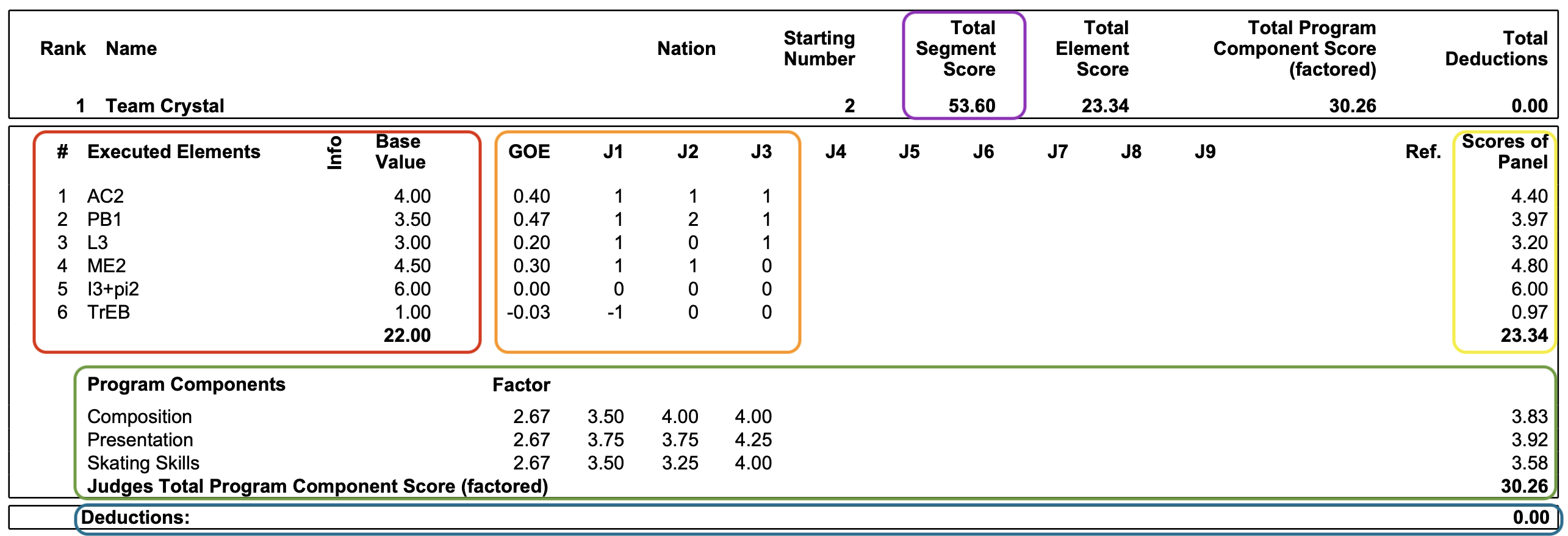In the IJS, competitors accumulate points based on the degree of difficulty (base value) of each technical element and how well each element is executed (grade of execution, or GOE). Skaters also earn points based on their overall skating ability and performance level through program component scores.
Understanding the Results Protocol

The Technical Score
Each element is assigned a base value (highlighted in red above). Elements have levels of difficulty on which the base values are decided. During the program, when a team/skater executes an element, the technical panel identifies each element and determines its level of difficulty (Level ”Base” to ”Level 4”). The levels of difficultly are decided each season by the ISU and SKF.
In the above protocol, we have six elements:
AC2 = Artistic Circle, level 2
PB1 = Pivot Block, level 1
L3 = Line, level 3
ME2 = Moves Element, level 2
I3 + pi2 = Intersection, level 3 plus Point of Intersection, level 2
TrEB = Traveling Element, level Base
Once the base value is determined, the judges assign the element a Grade Of Execution (GOE, highlighted in orange above) within a range of +5 to -5, which is added to or deducted from the base value:

The sum of all elements with the grade of execution forms the technical score (highlighted in yellow above).
The Program Components
The judges also award points on a scale from 0.25 to 10 (in increments of 0.25) for three program components to grade overall presentation (highlighted in green above).
As with GOEs, the highest and lowest scores for each component are thrown out, and the remaining scores are averaged. The final program components scores are then multiplied by a set factor to ensure the total element score and program components score are balanced.
The three program components are:
Composition – The intentional, developed and/or original arrangement of the repertoire of all types of movements
into a meaningful whole according to the principles of proportion, unity, space, pattern and musical structure.
Presentation – The demonstration of engagement, commitment and involvement based on an understanding of the
music and composition.
Skating Skills – The ability of the skater to execute the skating repertoire of steps, turns and skating movement, with blade and body control.
Deductions
Deductions (highlighted in blue above) can happen in the case of, among other things, a fall during the competition performance. If something is dropped on the ice during a performance, this can also lead to a deduction.
Total Segment Score
The total element score (highlighted in purple above) is added to the program components score to determine the segment score. The scores for each segment are then added together to determine the competition score. The skater with the highest competition score is declared the winner.
Who are the officials?
The Technical Panel
A technical panel of five people includes a technical controller, two technical specialists, a data operator and a video replay operator. During each performance, technical specialist 1 identifies each element and the level of difficulty as defined by the International Skating Union.
The technical controller and technical specialist 2 support the primary technical specialist to ensure all elements are correctly identified. Final decisions on elements and levels are determined by the majority opinion of the controller and two specialists.
Both specialists and the controller are recorded with an audio tape during each program, and video will be available to verify calls. The elements can be reviewed after a skater’s performance, and scores can be changed accordingly. The scores are final once they are posted and announced to the public.
The Judges
A maximum of nine judges make up the judging panel at a competition. The judges focus completely on scoring the quality of each technical element and the five program components for each skater. A computer keeps track of comparative scores, records results and calculates totals to determine placements.

